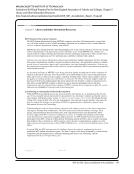114 · Representative Documents: Regional Accrediting Agency Reports
Brigham Young University
Northwest Commission on Colleges and Universities (NWCCU). Library and Information Resources 5
demonstrate the two units’ commitment to support student learning both inside and outside the
classroom.
Overall Library Funding
The Lee Library is funded almost entirely by university- budgeted resources. Figure 5.4
indicates that while the Lee Library’s largest budget allocation is for personnel (52.6 percent in
2005), over one-third is allocated for collections (35.6 percent). University funding allocated for
information technology and other capital equipment reflects an unusually strong commitment
from university administrators to support library needs. As digital content expands and as the
libraries stream digital multimedia to increasingly larger audiences, the need for increased digital
storage capacity continually grows.
Library programs are also supported through endowment funds, gift monies, and limited
business income. Endowment earnings help finance collection development (particularly in
Special Collections), digital initiatives, mentored student learning projects, and accessibility lab
equipment. Gift monies are used primarily for collections but also finance an increasing number
of special programs and events, such as an annual book collecting conference and a popular film
series where items from the Lee Library Film Archives are screened for both campus and local
community patrons.
Funding for Collections
Both Lee and Hunter collection development programs are strongly supported by the
BYU administration and the board of trustees.
As shown in figure 5.5, the Lee Library’s annual budget allocation for collections
(including books, journals, databases, and other materials) has increased by just over 6 percent
each year since 2001. The Hunter Library collections budget has not grown as rapidly, but during
the past two years the university has increased support for books and journals in the law library
as well. Expenditures for journals and databases in the Lee Library make up the largest category
of the collections budget. As expenditures for electronic resources grow, both book and journal
expenditures feel the impact. Figure 5.6 reflects 2005 collection expenditures, with 72.4 percent
spent on journals and databases and 22.1 percent on books.
Rapidly increasing prices make it difficult to sustain the libraries’ journal collections.
Electronic resources, such as commercially produced databases and texts, as well as locally
digitized materials, carry a high price tag and demand a growing percentage of the libraries’
collections budgets. Despite these challenges, strong university support allows the libraries to
maintain and even modestly expand collections during a time when many research libraries have
been forced to cancel journal subscriptions and reduce book purchases.
Even with strong budgetary support from the university, escalating costs have motivated
the libraries to set goals to dramatically increase their collection development endowments. The
Lee Library hopes to raise $8 million for general collections, $2 million for Special Collections,
and $10 million for digital content.
The ARL annual statistical report provides the best means of assessing the relative
strength of BYU’s support for library collections. Table 5.5 details all collection expenditures at
BYU, including budgeted and endowment funds, as compared to the ARL median. It also
Brigham Young University
Northwest Commission on Colleges and Universities (NWCCU). Library and Information Resources 5
demonstrate the two units’ commitment to support student learning both inside and outside the
classroom.
Overall Library Funding
The Lee Library is funded almost entirely by university- budgeted resources. Figure 5.4
indicates that while the Lee Library’s largest budget allocation is for personnel (52.6 percent in
2005), over one-third is allocated for collections (35.6 percent). University funding allocated for
information technology and other capital equipment reflects an unusually strong commitment
from university administrators to support library needs. As digital content expands and as the
libraries stream digital multimedia to increasingly larger audiences, the need for increased digital
storage capacity continually grows.
Library programs are also supported through endowment funds, gift monies, and limited
business income. Endowment earnings help finance collection development (particularly in
Special Collections), digital initiatives, mentored student learning projects, and accessibility lab
equipment. Gift monies are used primarily for collections but also finance an increasing number
of special programs and events, such as an annual book collecting conference and a popular film
series where items from the Lee Library Film Archives are screened for both campus and local
community patrons.
Funding for Collections
Both Lee and Hunter collection development programs are strongly supported by the
BYU administration and the board of trustees.
As shown in figure 5.5, the Lee Library’s annual budget allocation for collections
(including books, journals, databases, and other materials) has increased by just over 6 percent
each year since 2001. The Hunter Library collections budget has not grown as rapidly, but during
the past two years the university has increased support for books and journals in the law library
as well. Expenditures for journals and databases in the Lee Library make up the largest category
of the collections budget. As expenditures for electronic resources grow, both book and journal
expenditures feel the impact. Figure 5.6 reflects 2005 collection expenditures, with 72.4 percent
spent on journals and databases and 22.1 percent on books.
Rapidly increasing prices make it difficult to sustain the libraries’ journal collections.
Electronic resources, such as commercially produced databases and texts, as well as locally
digitized materials, carry a high price tag and demand a growing percentage of the libraries’
collections budgets. Despite these challenges, strong university support allows the libraries to
maintain and even modestly expand collections during a time when many research libraries have
been forced to cancel journal subscriptions and reduce book purchases.
Even with strong budgetary support from the university, escalating costs have motivated
the libraries to set goals to dramatically increase their collection development endowments. The
Lee Library hopes to raise $8 million for general collections, $2 million for Special Collections,
and $10 million for digital content.
The ARL annual statistical report provides the best means of assessing the relative
strength of BYU’s support for library collections. Table 5.5 details all collection expenditures at
BYU, including budgeted and endowment funds, as compared to the ARL median. It also
























































































































































































